Capri has two faces – here's the one you've never seen
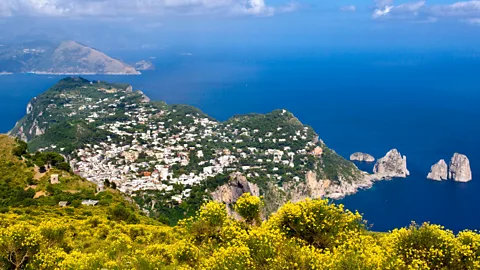 Alamy
AlamyThe Italian island immediately conjures up grand bougainvillea-draped villas and a whitewashed city centre, lined by luxury boutiques. But that's – literally – only half of the story.
"Bring water," they said when I announced I'd be hiking the Sentiero dei Fortini (Trail of Little Forts). "There's nothing out there."
The six-kilometre cliffside path linking the remains of three 19th-Century Bourbon military outposts was my fourth hike on this craggy Mediterranean island. Somewhere along the rocky, wild rosemary-flocked path while dodging spiky prickly pears, I realised that I'd only seen one other human in two hours. And there were indeed no water sources, aside from a rustic fountain I'd encountered a kilometre back at Fort Mèsola.
My Google Maps sputtered. I'd already got lost twice before noting that the ceramic path markers were low to the ground, cataloguing the area's flora and fauna – fig trees and wildflowers, wall lizards and falcons. The terrain faded from wilderness to sheer crags. Finally at the last fort, Fort Orrico, I could see straight down to the sea; a 30m death drop. The islands of Ischia and Procida loomed in the Gulf of Naples like the humps of petrified sea monsters. And I was completely alone at the island's edge; triumphant.
This is Capri. But perhaps not as you imagine it.
Typically, the word Capri conjures up bougainvillea-draped villas and luxury boutique-lined streets; a yacht dock for the glitterati and the perpetual artists' muse. Paul Feig's Another Simple Favor, which premiered on 1 May on Prime Video, is the latest film set against the island's opulent hotel culture and majestic cliffs, and is sure to inspire a fresh slew of Capri travel dreams.
But in Capri, glamour is – literally – only half of the story.
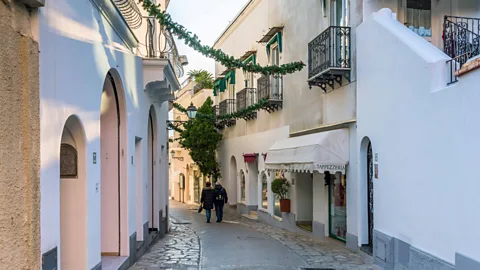 Alamy
AlamyAnacapri: Capri's rugged little sister
The camel-humped Capri – one of Italy's three volcanic Phlegrean islands – is actually home to two distinct towns. At the eastern end lies the princess Capri Town where loafer-wearing VIPs sip espresso in Piazza Umberto I; the faraglioni sea stacks winking in the distance. And at Capri's western end is her rugged little sister, the township of Anacapri; a sea cliff and prickly pear paradise where hiking boots replace stilettos and wild outdoorsy adventures trump wild nightlife.
Tip:
While Anacapri remains the island's outdoorsy paradise, Capri Town does have a few woodsy experiences of its own. Just push past the tourists and strike out from Piazza Umberto I or Via Camerelle towards the Punta Tragara lookout and the passeggiata del Pizzolungo. This clifftop trek offers incredible views of the faraglioni, passing the Arco Naturale – a Neolithic arch – and the Grotta di Matermania, the site of pagan rituals to the Goddess Mitra. Reward yourself with lunch at Le Grottelle for rustic island dishes and mesmerising Gulf views.
But while Capri sees as many as 16,000 visitors a day – outnumbering the 12,900 full-time residents – the majority only visit Capri Town.
"There's two main reasons for this," surmises Camilla Formisano, copyeditor at Caprionline. "Time and imagination. Seventy to 80% of visitors arrive on organised excursions from Naples, Sorrento or cruise ships. So they visit the most famous, easily accessible places from the port, like Piazza Umberto I."
Formisano also believes that social media plays a part: "People see the faraglioni and the piazza and think, 'I saw Capri'. Social media has condensed the island into a single postcard."
Social media is merely Capri Town's latest PR rep. Before becoming a premier Italian bucket list destination, Capri was a humble fishing island. It was settled by the Ancient Greeks, later becoming the seaside retreat of the Roman emperor Tiberius, who left grand villas in his wake. It wasn't until centuries later, when the Romantic poets and then Hollywood filmmakers turned their artistic eye on Capri Town, that it became a VIP haven. Today, visitors spill out from the ferry and throng the bus and funicular ticket booths to jockey for place in Piazza Umberto I, dodging motorised luggage carts and women in Instagrammable sundresses at every turn.
Meanwhile, it's just a 15-minute bus ride to Anacapri, where respite from Capri Town's day-tripper crowds and inflated prices await.
 Alamy
AlamyOrange blossom rambles and wild swimming
"Anacapri isn't completely free of overtourism," admits Formisano, referencing the tourist crush at the Blue Grotto, Villa San Michele and the chairlift to Monte Solaro. "But head west, through the Boffe [main] quarter towards the lighthouse and the Migliera [trail], and you'll find the island's heart."
Plan your trip
Arrive: Get to Anacapri via bus or taxi from Capri Town or Marina Grande. Download the ATC Go app to calculate bus routes and buy tickets.
Stay: The Giardino dell’Arte offers lovely rooms and a sprawling garden.
Eat:
• Aumm Aumm Family-friendly restaurant serving excellent Neapolitan-style pizza.
• Il Riccio Sea Lounge Jumeirah Capri Palace's luxe beach restaurant at the Blue Grotto.
• Ristorante La Zagara Restaurant inside a lemon grove. The neighbouring vinoteca offers gourmet aperitivi.
Anacapri is crisscrossed by stone-walled paths that yield to sudden sea views; perfumed in springtime by blooming orange trees. The terrain is hilly; locals zip by me on scooters and dusty motorised three-wheeled buggies. One wrong turn and I find myself either wheezing up a steep incline or at the cliff's edge.
Despite the divine aimlessness of wandering Anacapri on foot, its principal outdoor attractions are best reached with wheels. The ATC Capri Srl buses operate regularly between Piazza Vittoria, the Blue Grotto and Punta Carena, a craggy bay dominated by the island's rust-red 19th-Century lighthouse, where sunbathers splay themselves on the rocks or dive nose-first into the sea. Beach clubs are cut into the cliffs, the most beloved being da Antonio, a shack serving panini, gelato and an excellent crouton-and-aubergine panzanella salad. The upscale Lido del Faro features a pool and a full-service restaurant; I enjoy a bracing limoncello Spritz while watching the wild swimmers from above.
But Punta Carena is best known for its sunsets.
"It's the only place on Capri where the sun sets into the sea," says Formisano. "Thanks to Capri's particular shape, Anacapri remains sun-kissed until sunset. Sunsets here are a special experience, casting a golden light that envelops the landscape."
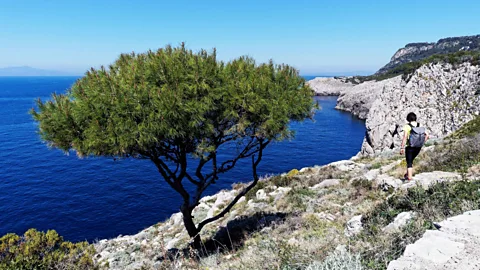 Alamy
AlamyEpic hikes with a view
It was Formisano who first directed me to the Trail of Little Forts. "A must-see," she called it.
Tip:
If starting the Trail of Little Forts from the Blue Grotto, take the Anacapri-Grotta Azzurra bus from Piazza della Pace until the Orrico stop, then head to the Piazzetta di Orrico to start the trail. Allow approximately three hours to complete.
The medium-difficulty trail runs along Anacapri's western coast between the Blue Grotto and Punta Carena. It's possible to start the trail at either end, but most trekkers begin at the Blue Grotto.
"So you can walk calmly immersed in nature, have a swim in Mèsola cove and get to the lighthouse by afternoon; just in time to enjoy an aperitif and the magnificent spectacle of the sunset over the sea," says Formisano.
Back in the Boffe quarter, Piazza della Pace is the origin point for two other brilliant Anacapri hikes; the Migliera trail and Mount Solaro.
"The Migliera is a narrow road winding through the countryside," says Formisano. "You'll come to a dramatic cliff overlook. Climb the ridge to the left; you'll get a really unique view of the faraglioni."
However, the view from Mount Solaro – Capri's highest point – is arguably the island's most famous. The 13-minute chairlift up the 589m mountain provides unforgettable views of terraced vineyards with the Amalfi Coast winking in the distance.
Vertigo? Summit Mount Solaro on foot by following Via Axel Munthe to Via Salita per il Solaro, keeping an eye out for stray mountain goats.
For any Anacapri hike, wear trail shoes; not your new Capri leather sandals. Before setting off, "stop at De Martino in Piazza Capri for an excellent panino", advises Formisano.
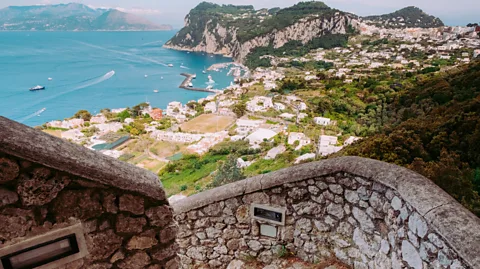 Getty Images
Getty ImagesAncient transport
Most people reach Anacapri by bus, but if you're fit, consider tackling the 1.7km Scala Fenicia, a 921-step flight of stone stairs chiselled into the cliffs by the Ancient Greeks; allowing countless generations of hardy Capresi to travel between Capri and Anacapri.
"It's not for everyone," admits Pep Minichino, founder of the Gulf of Naples-based blog, Campanica. Nonetheless, he encourages visitors to "embrace the experience! All you need is a Led Zeppelin anthem [in your head] for the energy to climb the famous zig-zag staircase."
The Scala Fenicia, which can be accessed from Marina Grande, leads straight up to Villa San Michele, the residence of the early 20th-Century Swedish physician and author Axel Munthe. The sprawling mansion – built over Roman ruins, featuring grand sitting rooms and Neoclassical gardens – is Anacapri's most touristed museum. But I came to climb, and my heart rate thunders as I bypass the tourist hordes at Marina Grande to undertake the trek, surrounded by olive trees, terraced lemon groves and, finally at the top, the sea.
"La Scala Fenicia is also open at night, so you can go down step by step," says Minichino. "Slowly. Aided in your descent by a cascade of lights and stars."
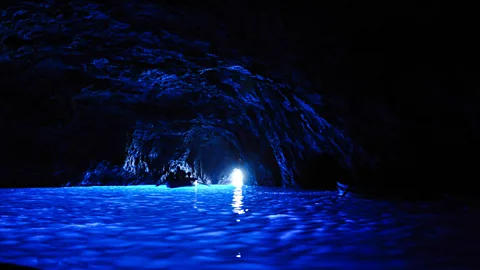 Alamy
AlamyNot-so-secret grottoes
By far, Anacapri's most visited attraction is the Blue Grotto (Grotta Azzurra), famed for its magical blue phosphorescence. Chaotic overtourism has engulfed this natural phenomenon, and I am overwhelmed by the massive queue and dozens of tourist-packed boats bobbing outside the grotto. But, once inside, the azure-blue light is breathtaking, and I am comforted as the boat captain's serenade of O Sole Mio echoes through the cave.
Formisano's hack: "The best way to visit the Blue Grotto is to be on the entrance steps at 09:00, arriving by land from Anacapri, not by sea from Marina Grande," she says. "This way you'll be first in line. You won't have to wait your turn on a rocking boat."
But to truly enjoy the seas of Anacapri, Formisano suggests doing as the Capresi do: "Going down to the Blue Grotto, follow the signs for "gradola" to reach a small terrace overlooking the sea with an excellent restaurant, a place frequented almost exclusively by locals."
Minichino agrees: "The best swimming, diving and sunbathing in Anacapri."
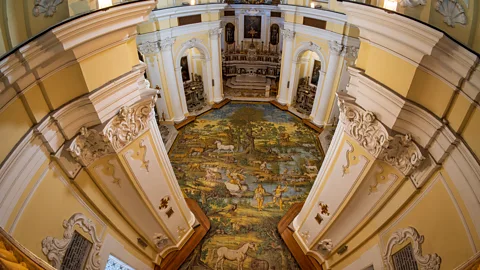 Getty Images
Getty ImagesQuiet village life
"After a day of outdoor activities in Anacapri, the best way to relax is to immerse yourself in the town's authentic, peaceful atmosphere," says Formisano.
My B&B, Giardino dell'Arte, is no sumptuous 19th-Century Capri Town palazzo, but my tidy room is floored with blue and white ceramic tiles, and orange blossoms spill over the wooden door. The courtyard overlooks a garden and the innkeeper offers me homemade ravioli alla Caprese; round ravioli stuffed with ricotta and herbs.
Strolling deeper into the Boffe quarter, I come upon La Casa Rossa, a bright red mansion built by the American colonel John Clay MacKowen in the early 20th Century; a quirky blend of architectural styles ranging from medieval to Middle Eastern. There are generational bakeries in leaf-shaded alleys where I buy fistfuls of sour cherry pastries and pizzette.
But the neighbourhood stunner is the Chiesa Monumentale di San Michele Arcangelo, a petite Baroque church with a show-stopping majolica floor in ochres and blues depicting the Fall of Eden. The tiles can only be viewed from strategically positioned wooden boards or from the balcony above. Wide-mouthed crocodiles, lions and hooved Biblical beasts leer up at me, Adam and Eve at the centre of the fray.
It's my favourite view island… until the rooftops.
Because Anacapri is still Capri, just off the Boffe quarter there are two opulent hotels; Jumeirah Capri Palace and the historic Hotel Caesar Augustus, a palatial structure dating to 1850 whose clifftop terrace seems to extend into the sea. I charm my way into both, and wind up on their rooftop bars as the sun sinks pink and purple into the Gulf of Naples, throwing Ischia and Procida into bas relief. Another limoncello Spritz, and I sink into a luxurious armchair, crossing my dusty ankles in their hiking boots; princess and athlete all at once.
--
If you liked this story, sign up for The Essential List newsletter – a handpicked selection of features, videos and can't-miss news, delivered to your inbox twice a week.
